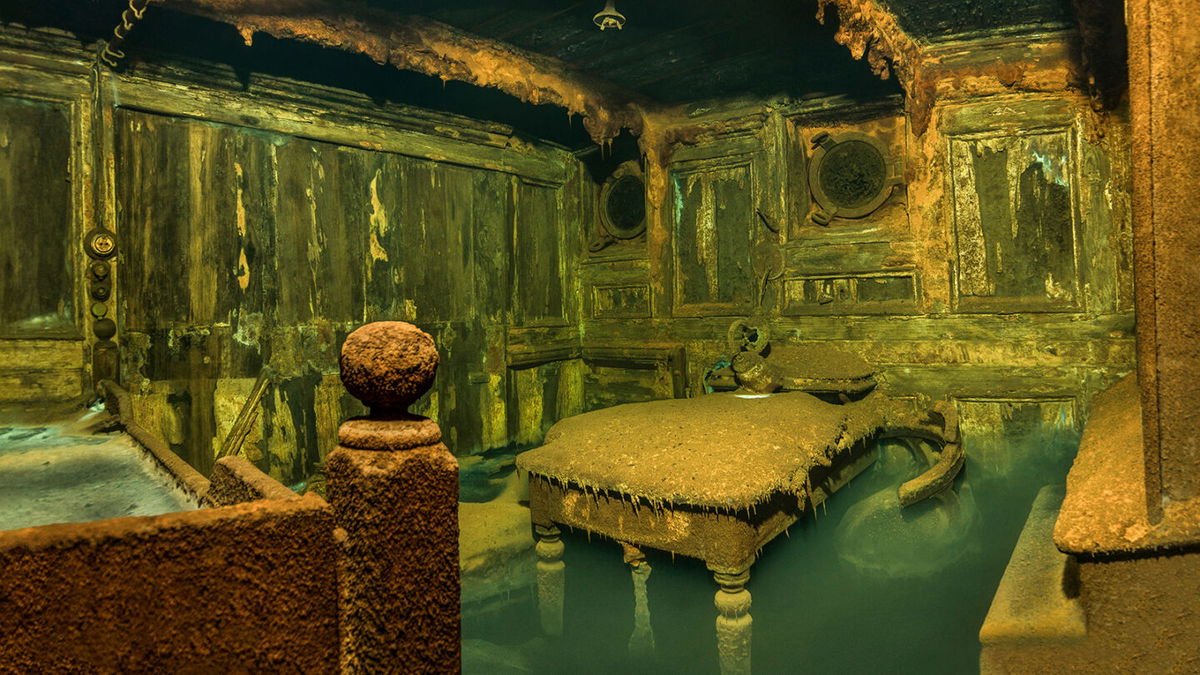Inside the ‘ghost ships’ of the Baltic Sea

Dahm took this photograph of the interior of what was once a passenger cabin on board the Aachen
Francesca Street, CNN
Plunging into the icy waters surrounding Scandinavia, divers Jonas Dahm and Carl Douglas hunt for vessels long lost to the ocean, what they call the “ghost ships” of the Baltic Sea.
Dahm and Douglas are history lovers and long-time friends who’ve devoted some 25 years of their lives to wreck hunting and research.
While many of the barnacle-clad vessels claimed by the Baltic Sea have lain in wait for centuries, some are in remarkably good condition due to the preservative effects of the water’s chilly temperatures.
On dives, Dahm captures haunting photographs. Intact ship furniture, detailed interior wall carvings and an only-slightly-cracked ship’s clock have all been snapped on the seabed.
Dahm and Douglas also spend hours poring over books, researching the wrecks’ histories.
A selection of Dahm’s eerie photographs, paired with Douglas’ written reflections, feature in the book “Ghost Ships of the Baltic Sea,” published by Swedish publisher Bokförlaget Max Ström.
In the depths of the sea
The Baltic Sea has been a center for seafaring activity for centuries — from maritime trade to maritime conflict. Inevitably, that means a long history of ships claimed by the waves.
In the book, Douglas writes there are “tens of thousands of intact, undisturbed shipwrecks from every era” submerged in Baltic’s watery depths.
“There still are many that haven’t been found yet,” Dahm tells CNN Travel.
The Baltic Sea’s potential wealth of well-preserved wrecks makes it the home of “the best diving in the world,” says Douglas.
Dahm and Douglas first met in the late 1990s through mutual diving friends in Stockholm, Sweden. Dahm’s been diving since he was a teenager, honing his underwater photography skills during his compulsory military service.
In contrast, Douglas admits he avoided the ocean for a long time.
“I was scared of water — but things that scare often also fascinate,” he tells CNN Travel. After a bit of persuasion from friends, he gave diving a shot.
“After that I was hooked,” he says, while admitting he still gets seasick on boats.
Photographing underwater
Each of Dahm’s images are bathed in a viridescent ocean hue, but key details are also illuminated, as Dahm moves between capturing the heft of the lost ships and zooming in on haunting details.
In the book, Douglas writes about how the divers use “darkness to our advantage.”
“Balancing the natural light from the surface with flashlights and covering as much as possible of the wreck site is the goal,” he says.
Photographer Dahm, who uses Nikon D850 and Fujifilm GFX 100s medium format cameras, works with other divers to maximize time spent under the sea.
“To take the big wide-angle pictures we sometimes are two to three divers working together, while I usually can handle close-ups images by myself,” he explains.
As well as light, there are are other challenges associated with photographing wrecks — the cold, of course, and the sometimes-opaque visibility.
And there’s the depths, which mean Dahm and Douglas and their team can’t ever linger. The ships featured in the book are submerged as deep as 110 meters (360 feet) under sea.
“At that depth you don’t have very much time to take the photos the way you want,” says Dahm.
Unknowable stories
Douglas and Dahm plan trips to particular sites to see particular ships. They get tips from local fishermen, and other times follow in the footsteps of other divers.
But sometimes “a wreck will appear almost randomly on our echo sounder,” as Douglas puts it in the book. Dahm and Douglas love spending time researching the history of their discoveries — particularly when they stumble across anonymous ships, story unknown.
For Dahm, it’s one of these more mysterious wrecks that stands out to him. He calls the ship, the “porcelain wreck,” because it’s still home to treasures includes violins, clay pipes and pocket watches — and yes, several pieces made of porcelain.
“We don’t know its name, why it sank or where it was headed. All we know is that the ship had a valuable cargo and that it did not reach its destination,” says Dahm.
Dahm and Douglas are careful not to damage the wrecks during their exploration. They’re passionate about preserving the sea and marine life. They also approach their photography and their book with respect and care.
“In many cases they represent disasters where people lost their lives under terrible circumstances,” writes Douglas in the book. “We visit these sites with enormous respect, and we do it to honor the victims and tell the story of what happened.”
The book is led by Dahm’s photographs, but Douglas’ accompanying text brings many of the stories to life. He says he wanted his writing to offer insight — there’s input from experts like Dr. Fred Hocker, director of research at Stockholm’s Vasa maritime museum — but the writing also leaves room for questioning and reflecting.
“The writing follows the images,” says Douglas. “We want the reader to really feel the wrecks. Sometimes too much information can ruin that.”
And while the divers love to discover answers to their questions in their research, they also accept not every story is knowable, and find something strangely satisfying in that unknown.
“Sometimes we have to resign ourselves that we will never know the full history — but these mystery wrecks are also very attractive,” says Douglas.
“I will probably never know the answers to all these questions, but it’s okay, most shipwrecks will never reveal their secrets anyway,” says Dahm.
The-CNN-Wire
™ & © 2023 Cable News Network, Inc., a Warner Bros. Discovery Company. All rights reserved.
